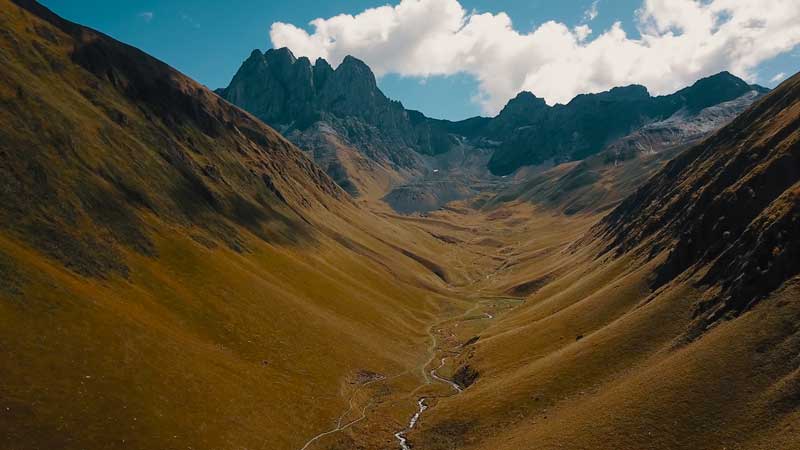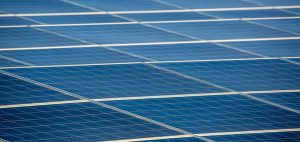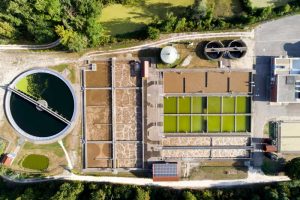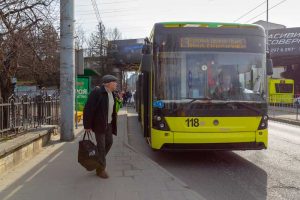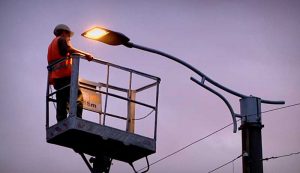Impact in the green economy
Introduction
We are changing lives and the environment, providing finance for high-impact projects with environmental benefits that support, most notably, climate adaptation and cleaner energy sources. We finance these through our Green Economy Transition (GET) approach which is helping create low carbon and resilient economies in our regions. Some 80 per cent of GET projects are financed through direct investments using our unique business model financing green investments, mobilising concessional financing, engaging in policy dialogue and facilitating technical support.
Key operational
results in 2018
through
GET accounted for
annual CO2 emission reductions
*Of this figure, 3 MtCO2-equivalent is the expected net emissions reduction resulting from the completion of the TAP natural gas pipeline. This project will deliver up to 10.4 billion cubic metres of natural gas to Europe after 2020, which will contribute to the reduction of the carbon intensity and energy mix in the end-user markets, notably in the Greek and Bulgarian power sectors. Consumption of this gas will result in gross emissions of around 22 MtCO2-equivalent per year.
Green Economy Transition
Introduction
The EBRD is an international leader in the transition to a green economy with its Green Economy Transition (GET) approach building on over a decade of successful climate, resource efficiency and environmental investments. When we launched GET at the end of 2015, we sought to increase the Bank’s volume of green financing from an average of 25 per cent of our Annual Bank Investment (ABI) over the last decade to 40 per cent by 2020. At the end of 2018 we achieved 36 per cent.
The GET approach builds on more than two decades of experience in financing green investments, with an initial focus on energy efficiency and renewable energy. This was later expanded to resource efficiency and climate resilience, thereby putting investments that bring environmental benefits at the heart of our mandate.
The EBRD uses a unique business model of financing green investments, mobilising concessional financing, engaging in policy engagement and facilitating technical support.
Key operational results 2006-18
(equivalent to more than annual energy emissions of Romania)
energy saved per year
| GHG reduced | Mt/y | 7.1 |
| Water saved | million m3/y | 126 |
| Renewable electricity produced | million MWh/y | 2.3 |
| Renewable capacity installed | MW | 877 |
| Primary energy saved | million GJ/y | 27.6 |
A new energy strategy
In December 2018 the EBRD adopted its energy sector strategy for 2019-23. The strategy emphasises the scaling-up of investment in renewables, supporting the integration of energy systems, promoting the switch to cleaner and more resilient energy sources and facilitating electrification as a means to clean up the economies where the Bank invests, which include some of the least energy-efficient and most polluting regions in the world.
Consistent with this direction the strategy confirms that the Bank will no longer finance thermal coal mining or coal-fired electricity generation. The Bank will also stop funding any upstream oil exploration, and will not finance upstream oil development projects except in rare and exceptional circumstances, where such investments reduce greenhouse gas emissions.
Nandita Parshad, EBRD Managing Director, Energy and Natural Resources, said: “The challenges posed by climate change and poor air quality require a fundamental shift away from hydrocarbons to cleaner energy sources. This is the goal of our new energy sector strategy: to decarbonise the power sector with a move away from the most polluting fuels. As investors and facilitators of policy reform, we are committed to promoting environmentally sound and sustainable development and are ideally placed to deliver this transition.”
“…we are committed to promoting environmentally sound and sustainable development…”
Nandita Parshad, EBRD Managing Director, Energy and Natural Resources
EBRD invests in desert solar power
The Bank provided a loan of US$ 30.6 million to Desert Solar Power One LLC to support the construction of a 30MW solar photovoltaic (PV) power plant located in the Sainshand Soum in Mongolia. It is expected that it will decrease the country’s dependency on old and highly polluting coal-fired combined heat and power plants and that it will reduce CO₂ emissions by 47,606 tonnes per year.
Investing in the green economy
Renewable energy
In 2018, we invested €486 million into renewable energy. Helping develop low-carbon sources of electricity is one of the ways the EBRD can contribute most directly to mitigating climate change. In 2018 we supported wind, solar, hydro and biogas projects across our regions.
EBRD Green Cities
EBRD Green Cities strives to build a better and more sustainable future for cities and their residents. Launched in 2016 and building on our extensive experience investing in municipal infrastructure, the programme identifies, prioritises and connects cities’ environmental challenges with sustainable infrastructure investments and policy measures.
The programme has mobilised over €1 billion in EBRD and donor support, and has signed 16 projects to help support cities to develop their Green City Action Plans (GCAPs). Since its inception, the programme has reduced annual GHG emissions in EBRD cities by 370,000 tonnes CO2 e, which is equivalent to permanently removing around 100,000 cars from the road. In December 2018 we launched the EBRD Green Cities website, which provides details and up-to-date information on the programme and GCAPs.
EBRD Green Cities has three central components:
- Green City Action Plan: assessing and prioritising environmental challenges, and developing an action plan to tackle these challenges through policy interventions and sustainable infrastructure investments. Three GCAPs have been completed in Yerevan, Tbilisi and Tirana and another 11 are under way in cities from Central Asia to the SEMED region.
- Green sustainable infrastructure investment: facilitating and stimulating public or private green investments in water and wastewater, urban transport, district energy, energy efficiency in buildings, solid waste management and other interventions that improve the city’s adaptation and resilience to climate shocks.
- Capacity-building: providing technical support to city administrators and local stakeholders to ensure that infrastructure investments and policy measures identified in GCAPs can be developed, implemented and monitored effectively.
Resource and energy efficiency
Energy efficiency is critical for a country’s economy. It lowers CO2 emissions, supports energy security and enhances competitiveness. Using resources more efficiently reduces waste, protects the environment and makes businesses profitable. In 2018 EBRD invested over €1 billion in projects that promote energy and resource efficiency. Our 2018 projects in energy and resource efficiency have included:
Energy efficient refurbishment of Zenica Cantonal Hospital
We provided €10 million to the government of Bosnia and Herzegovina under the Green Cities Framework. Proceeds will finance the energy efficient refurbishment of the hospital, supplemented by a €1 million investment grant from the Regional Energy Efficiency Programme for the Western Balkans.
EBRD boosts sanitation infrastructure in Lviv
We provided a €20 million loan to Zelene Misto, a municipal solid waste operator in Lviv, Ukraine. The funds will allow the rehabilitation of Hrybovychi landfill and the building of a mechanical and biological treatment facility. This investment will improve the efficiency of the solid waste management system, including the separation and collection of recycling material. It will also contribute to the city’s targeted 20 per cent reduction in CO₂ emissions by 2020.
Supporting energy efficiency in Hungary
The Bank provided a seven-year €200 million Eurobond issuance with a €25 million subscription. Proceeds will support assist Hungarian fertiliser producer Nitrogénművek Zrt’s to apply modern technologies in neutralisation and ammonia plants. It will also support improvements in energy efficiency, helping the company curb its carbon intensity and reduce natural gas consumption per tonne of ammonia produced by 9.2 per cent. It is also expected to reduce carbon emissions of 135,600 tonnes annually.
Türkiye Materials Marketplace
This cloud-based circular economy platform, facilitates cross-industry materials re-use among Turkish companies and communities. As of December 2018, it had 60 member companies in Turkey. Five material exchanges had taken place through the platform – four involved exchange of electronic wastes (fluorescent bulbs, toner cartridges and IT equipment), the other involved eggshell waste bought by a chemical company to produce natural food preservative.
Green Innovation vouchers scheme in Ukraine
In 2018 our innovation voucher schemes, which promote resource efficiency and the use of green technologies, supported 29 projects in Serbia and 26 projects in Ukraine worth a combined €1,300,000. Innovation vouchers are grants that can be used by companies to purchase R&D services from local providers, enabling participating companies to raise their environmental performance and competitiveness. The aim of the schemes is to support the development of innovative products and services that come from various sectors including precision agriculture, e-mobility, waste management, renewables and eco-friendly products.
Nova Poshta
The Bank provided a loan of €9.5 million to Nova Poshta LLC, the largest private postal operator in Ukraine. The proceeds will be used to automate the existing infrastructure to optimise the supply chain. The project is also supported by the FINTECC programme which helped the firm upgrade to a 24-hour automated sorting process, which divides parcels into different streams and allows a shorter loading process. The project will allow CO2 emission reductions of 1,600 tonnes per year.
Finance and Technology Transfer Centre for Climate Change (FINTECC)
Our Finance and Technology Transfer Centre for Climate Change (FINTECC) programme helps companies implement cutting edge technologies that reduce GHG emissions, water, energy or material consumption, or assist clients in becoming more resilient to the effects of climate change. FINTECC’s objective is to raise awareness and support the adoption of these innovative technologies which, despite having significant carbon reduction benefits, have not yet become popular in the economies where we invest. The programme helps spread their use through grants, policy engagement and technical cooperation. The programme is funded by the Global Environment Facility (GEF), the European Union (EU) and the EBRD Shareholder Special Fund (SSF).
Since the launch of the FINTECC programme in 2014, 42 projects have been signed that include a FINTECC component, for a total investment by the EBRD of over €135 million. In 2018, 10 new projects were signed resulting in a CO2 emission saving of over 45,000 tonnes per year.
Green Economy Financing Facilities (GEFFs)
Our Green Economy Financing Facilities (GEFFs) support businesses and homeowners to invest in green technologies. Over €4 billion worth of climate finance has already been used to invest in more than 165,000 green technology upgrades, collectively avoiding more than 8 million tonnes of CO2 emissions per year. This has been achieved through a network of more than 140 local financial institutions across 26 countries.
2006-18 in numbers
Since 2006, this programme has achieved:
third quarter of 2018
per year from GEFF projects
Technology Catalogue
In May 2018, EBRD launched the Technology Catalogue, an online shopping-style platform that helps vendors of green technologies to connect with businesses and homeowners. The platform is vendor driven for the registration of technologies that outperform current industry peers. Experts hired by the EBRD verify the performance and availability of these technologies before they are listed. These best-in-class technologies from around the world lead to clear-cut efficiency gains and serve as a basis for market-specific “Technology Selector” platforms.
Case studies
In 2018 we launched seven major GEFF initiatives in countries ranging from Poland to Lebanon.
- EBRD and Bank Audi partner for first green finance project in Lebanon
- EBRD lends €6 million to Union Bank to boost green energy investments in Albania
- EBRD and partners launch energy efficiency programme for Serbian homes
- EBRD launches energy efficiency programme for homes of North Macedonia
- EBRD launches energy efficiency framework for homes in Kosovo
- First EBRD loan under new €350 million green facility
- EBRD finances green investments at Poland’s Millennium Leasing
Green TFP has contributed
Green Trade
As part of our efforts to promote the development of the green economy we support trade in higher performance technologies.
Since 2016, our Trade Facilitation Programme (TFP) has been implementing the Green TFP: an innovative marketing initiative which aims to stimulate the supply of green technologies into the economies where we invest, particularly into markets where demand is generated via the GEFFs.
Over the course of 2018, the Green TFP has contributed more than €100 million in GET financing. More than 190 Green TFP transactions have been financed in 10 EBRD economies, resulting in estimated annual energy savings of 187,028 MWh, water savings of 1,573,133m3 and emission reductions of 60,133 tonnes CO2 e.
Notable transactions in 2018 have included the import of LED lighting from Belgium to Cyprus, the import of ground source heat pumps from Sweden to Serbia, the import of agricultural machinery and equipment from Austria to Moldova and from France to Ukraine; as well as transactions supporting resource efficiency, such as the import of water-saving technologies for buildings from Italy to Mongolia and the export of water treatment equipment from Greece to Egypt.
Climate resilience
Addressing climate resilience is an integral part of the EBRD’s approach to the green economy. The challenges of a changing climate are felt keenly in many of the economies where we invest. This is partly due to location, but also because under-investment has resulted in ageing, inefficient infrastructure and facilities.
We support projects focused on adaptation: that is, they help our clients invest in measures and technologies to address the physical risks associated with climate change and strengthen their climate resilience. We also screen all our projects for climate vulnerability.
In 2018
projects signed
Since 2011
projects signed
adaptation finance
adaptation finance
EBRD finances upgrade of Enguri HPP
EBRD supports Kyrgyz Republic Water and Wastewater Framework
With a loan of up to €5.5 million under the Kyrgyz Republic Water and Wastewater Framework to finance critical water and wastewater improvements, including network rehabilitation, metering, and procurement of operational and maintenance equipment. The project is expected to save 8,100,000 m3 of water annually.
Municipal and environmental infrastructure
Introduction
Our investments in the municipal and environmental infrastructure (MEI) sector provide millions of people with access to safe drinking water, sanitary waste disposal services, green public transport, well-maintained urban roads and energy-efficient district heating.
Key figures
improved access to tap water
improved access to wastewater services
access to improved solid waste management
access to improved district heating
In 2018
Our MEI investments leveraged considerable volumes of loan and grant co-financing from commercial banks, the European Union (EU) and other sources.
Raja
We loaned up to €25 million to Raja SA, Romania’s largest public water and wastewater utility which serves over three million people in the city of Constanta. The first tranche will co-finance the extension and modernisation of the company’s water supply and sewerage infrastructure, benefiting 400,000 people. The second will finance the reduction of its non-revenue water.
Low carbon pathways: trolleybuses in Kharkiv and Kryvyi Rih
The Bank committed two loans for a total of €16 million to the municipal public transport operators in the cities of Kharkiv and Kryvyi Rih in Ukraine. The EBRD funds were complemented by €4 million from the Clean Technology Fund. The proceeds were used for fleet renewal and infrastructure modernisation.
Key figures
GET approach
Transport
Introduction
We help make transport infrastructure more resilient to the impacts of climate change and enable significant emissions reductions via modal shift, energy efficiency and capacity increases to conduct emissions assessments. There are about 85,000 road-related deaths in our economies each year, and countless injuries. In total, a staggering US$ 110 billion in GDP is estimated to be lost annually due to poor road safety. We prioritise health and safety and make road audits an integral part of our due diligence process.
2018 highlights
We funded several capacity-building and technical assistance projects: in North Macedonia we improved the standards and training of local engineers in road safety; in Belarus and North Macedonia we implemented a road sector governance action plan; in Bosnia and Herzegovina we promoted inclusive procurement practices and training opportunities for young people.
We are also expanding our engagement on e-mobility and during 2018 we worked with the Egyptian authorities to develop an all-encompassing e-mobility strategy. The aim is to remove barriers impeding the uptake of electric vehicles to create a more inclusive investment environment.
We also improved governance and management practices. In the Port of Montenegro we introduced ISO management certifications on quality, the environment and occupational health and safety. We financed research and development investments for a ship building client directly relating to development of the first Tier III tug boat, with reduced nitrous oxide (NOx) emissions being produced in Turkey and in Europe.
We signed an MoU with the International Maritime Organisation (IMO) in February 2018 focusing on our joint efforts and mobilisation of funding to improve sustainability and energy efficiency within the sector. We funded two capacity-building exercises in Morocco and Georgia alongside the IMO and local port operators for port emission inventories and developing abatement and investment strategies.
Special environmental programmes: the E5P and NDEP
Introduction
The EBRD has a global reputation for its work in challenging economies and in complex environments – including where nuclear safety is a concern. This is why donors and other IFIs asked us to manage, on their behalf, two multilateral funds created to address environmental, nuclear safety and climate change challenges in eastern Europe. As the fund managers of the E5P and NDEP since their inception, we drive the reform agenda and policy engagement and actively seek new contributions and new project opportunities for both programmes.
The Eastern Europe Energy Efficiency and Environment Partnership (E5P)
The E5P is a multi-donor fund created in 2010 which aims to facilitate investment in energy efficiency and environmental projects, reduce greenhouse gas emissions and promote policy engagement and regulatory reforms in the Eastern Partnership countries. The E5P’s initial focus was Ukraine, where the district heating sector presents a unique opportunity for saving energy and cutting CO2 emissions. The Fund now also operates in Armenia, Belarus, Georgia and Moldova.
The NDEP
The Northern Dimension Environmental Partnership (NDEP)
The NDEP, a multi-donor fund created in 2002, deals with nuclear and environmental challenges in the north-west of Russia and northern Belarus. In 2018, a specially designed infrastructure was commissioned for the removal of spent nuclear fuel from the Lepse ship located near Murmansk.
The environmental activities of the fund also focus on reducing untreated wastewater flowing to the Baltic and Barents Seas. In 2018 the city of Baranovichi in Belarus received a €1.5 million grant to upgrade its wastewater treatment facilities, marking the third phase of the EBRD’s water projects there. Also in 2018, NDEP considered new proposals to tackle black carbon emissions in the Arctic, which contribute to climate change
Gymuri, Armenia lighting system upgrade
The Armenian city of Gyumri received a grant of €2 million from E5P to upgrade its street lighting system after a huge earthquake in 1988 which destroyed its infrastructure. This EBRD regeneration project will create a better service quality, energy consumption savings of 70 per cent, new employment opportunities, increased road safety and will deliver many social and gender-specific benefits including improved visibility.


